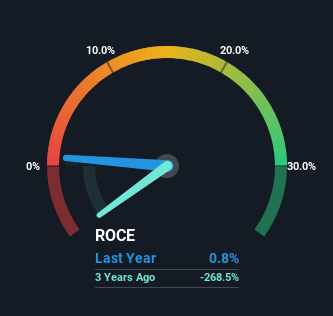- Hong Kong
- /
- Trade Distributors
- /
- SEHK:166
New Times Energy (HKG:166) Will Be Hoping To Turn Its Returns On Capital Around

If you're looking at a mature business that's past the growth phase, what are some of the underlying trends that pop up? A business that's potentially in decline often shows two trends, a return on capital employed (ROCE) that's declining, and a base of capital employed that's also declining. Basically the company is earning less on its investments and it is also reducing its total assets. And from a first read, things don't look too good at New Times Energy (HKG:166), so let's see why.
What Is Return On Capital Employed (ROCE)?
For those that aren't sure what ROCE is, it measures the amount of pre-tax profits a company can generate from the capital employed in its business. Analysts use this formula to calculate it for New Times Energy:
Return on Capital Employed = Earnings Before Interest and Tax (EBIT) ÷ (Total Assets - Current Liabilities)
0.0076 = HK$15m ÷ (HK$2.3b - HK$392m) (Based on the trailing twelve months to June 2023).
Thus, New Times Energy has an ROCE of 0.8%. Ultimately, that's a low return and it under-performs the Trade Distributors industry average of 6.3%.
Check out our latest analysis for New Times Energy

Historical performance is a great place to start when researching a stock so above you can see the gauge for New Times Energy's ROCE against it's prior returns. If you want to delve into the historical earnings, revenue and cash flow of New Times Energy, check out these free graphs here.
What The Trend Of ROCE Can Tell Us
The trend of ROCE at New Times Energy is showing some signs of weakness. The company used to generate 9.0% on its capital five years ago but it has since fallen noticeably. What's equally concerning is that the amount of capital deployed in the business has shrunk by 45% over that same period. When you see both ROCE and capital employed diminishing, it can often be a sign of a mature and shrinking business that might be in structural decline. Typically businesses that exhibit these characteristics aren't the ones that tend to multiply over the long term, because statistically speaking, they've already gone through the growth phase of their life cycle.
On a side note, New Times Energy's current liabilities have increased over the last five years to 17% of total assets, effectively distorting the ROCE to some degree. Without this increase, it's likely that ROCE would be even lower than 0.8%. While the ratio isn't currently too high, it's worth keeping an eye on this because if it gets particularly high, the business could then face some new elements of risk.
Our Take On New Times Energy's ROCE
In summary, it's unfortunate that New Times Energy is shrinking its capital base and also generating lower returns. Investors haven't taken kindly to these developments, since the stock has declined 43% from where it was five years ago. That being the case, unless the underlying trends revert to a more positive trajectory, we'd consider looking elsewhere.
Like most companies, New Times Energy does come with some risks, and we've found 3 warning signs that you should be aware of.
While New Times Energy isn't earning the highest return, check out this free list of companies that are earning high returns on equity with solid balance sheets.
If you're looking to trade New Times, open an account with the lowest-cost platform trusted by professionals, Interactive Brokers.
With clients in over 200 countries and territories, and access to 160 markets, IBKR lets you trade stocks, options, futures, forex, bonds and funds from a single integrated account.
Enjoy no hidden fees, no account minimums, and FX conversion rates as low as 0.03%, far better than what most brokers offer.
Sponsored ContentValuation is complex, but we're here to simplify it.
Discover if New Times might be undervalued or overvalued with our detailed analysis, featuring fair value estimates, potential risks, dividends, insider trades, and its financial condition.
Access Free AnalysisHave feedback on this article? Concerned about the content? Get in touch with us directly. Alternatively, email editorial-team (at) simplywallst.com.
This article by Simply Wall St is general in nature. We provide commentary based on historical data and analyst forecasts only using an unbiased methodology and our articles are not intended to be financial advice. It does not constitute a recommendation to buy or sell any stock, and does not take account of your objectives, or your financial situation. We aim to bring you long-term focused analysis driven by fundamental data. Note that our analysis may not factor in the latest price-sensitive company announcements or qualitative material. Simply Wall St has no position in any stocks mentioned.
About SEHK:166
New Times
An investment holding company, engages in exploration, development, and production of natural resources in Hong Kong, Canada, Mainland China, and Argentina.
Flawless balance sheet and slightly overvalued.
Market Insights
Community Narratives



